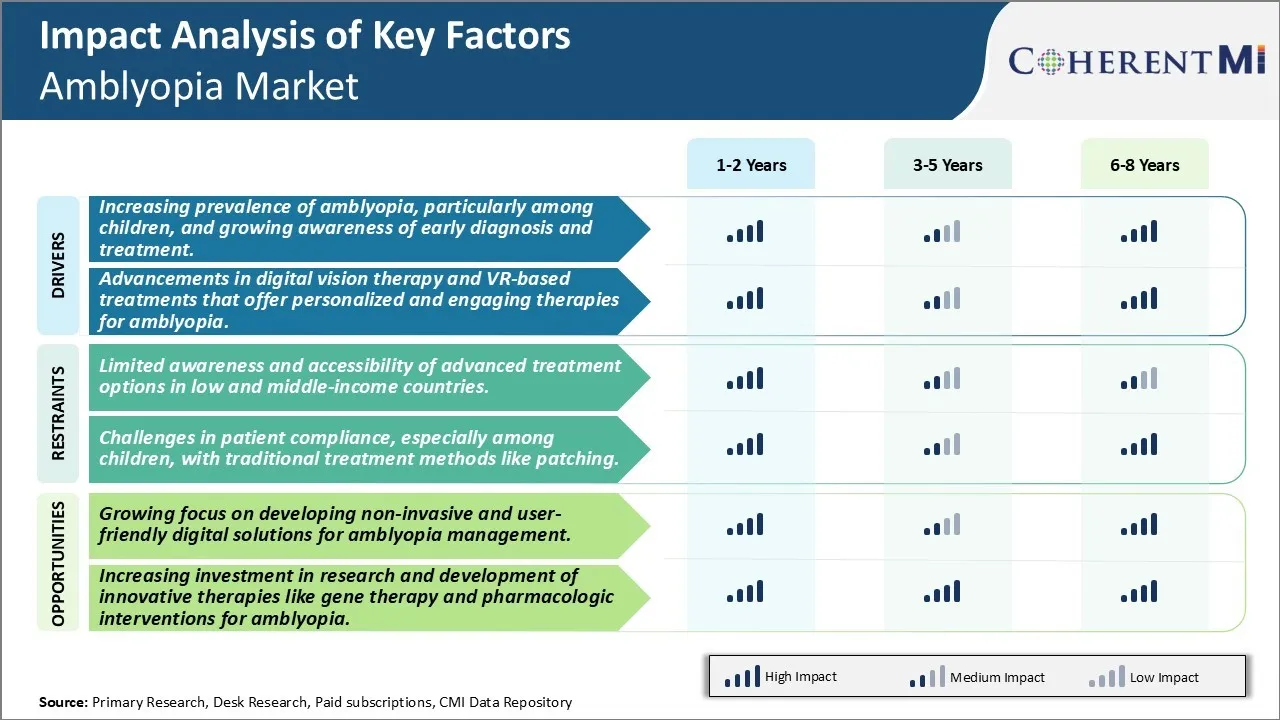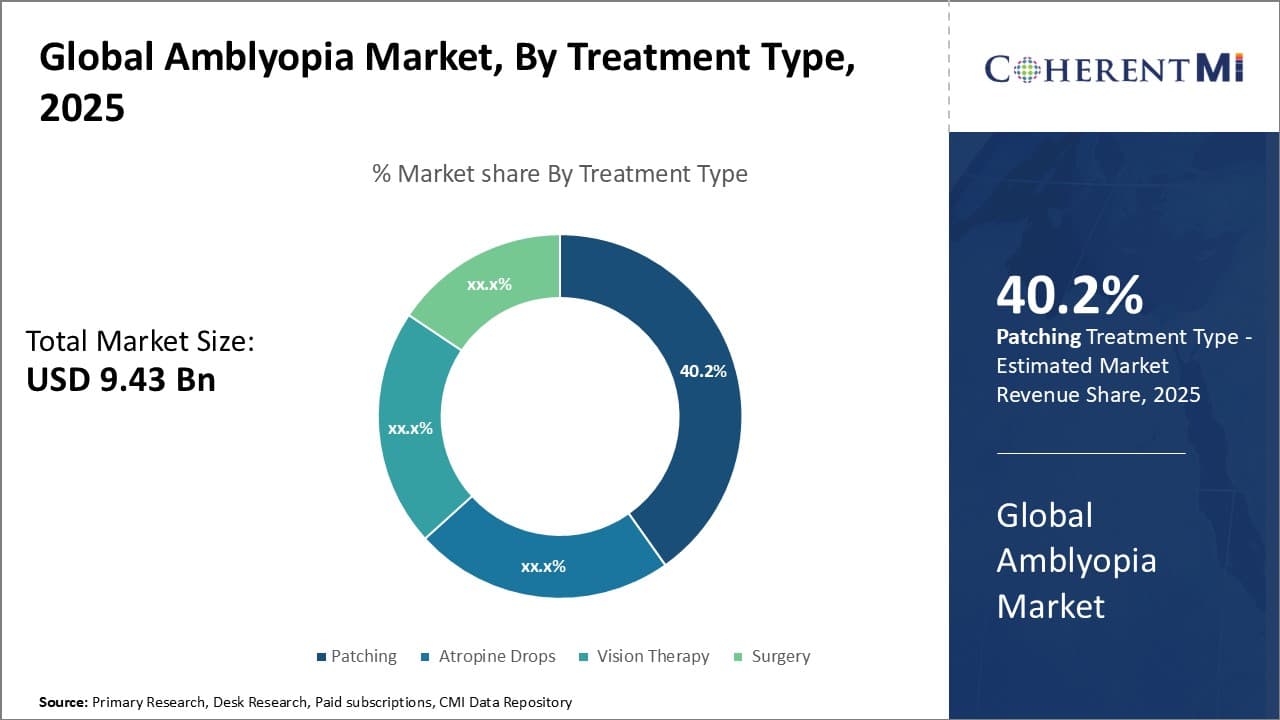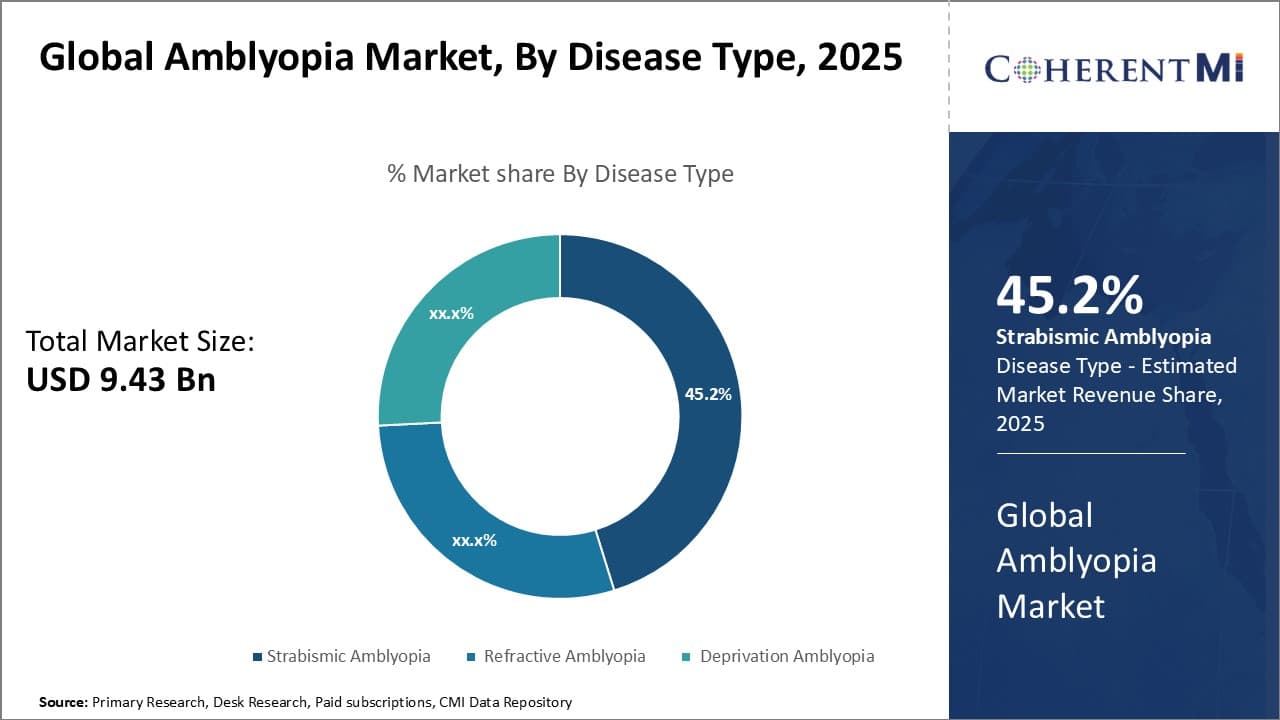

The Global Amblyopia Market is estimated to be valued at USD 9.43 Bn in 2025 and is expected to reach USD 14.18 Bn by 2032, growing at a compound annual growth rate (CAGR) of 6.00% from 2025 to 2032. Amblyopia, commonly known as lazy eye, refers to reduced vision in one or both eyes due to lack of visual stimulation during early childhood development. If left untreated, it can lead to permanently reduced vision. The increasing cases of lazy eye among children and the need for early detection and treatment are major factors contributing to the growth of this market.
The market is witnessing positive trends with growing awareness regarding amblyopia among parents and initiatives by governments worldwide to screen children from ages 3 to 5 years. Various technological advancements in diagnosis and treatment such as new screening tools, prescription lenses, eye patches, and atropine eye drops are further supporting market growth. However, high treatment costs and lack of awareness in developing regions continue to restrain the amblyopia market to some extent.
Market Size in USD Bn
CAGR6.00%
| Study Period | 2025-2032 |
| Base Year of Estimation | 2024 |
| CAGR | 6.00% |
| Market Concentration | Medium |
| Major Players | Novartis, Bausch & Lomb, Vivid Vision, Ocumetics Technology Corporation, RevitalVision and Among Others |
Market Driver - Increasing Prevalence of Amblyopia, Particularly Among Children, and Growing Awareness of Early Diagnosis and Treatment.
The increasing prevalence of amblyopia, commonly known as lazy eye, is one of the primary drivers for the market growth. Amblyopia is estimated to affect 2-5% of the global population, and a majority of these cases are among young children between ages 3 to 7 years. Some of the key risk factors associated with amblyopia in kids include being born prematurely, family history of lazy eye, developmental delays, eye turns such as strabismus, and high refractive errors which lead to blurred vision. Early diagnosis and treatment of amblyopia is critical as it impacts the vision development of the eyes during the formative years and can be treated effectively only when detected at an earlier stage. However, many cases still remain undiagnosed or detected very late. This has led to growing awareness among parents, health professionals and eye care specialists about the importance of screening young kids' vision regularly through programs conducted at schools, daycare centers and pediatrician's offices. Special emphasis is now given to test vision between ages of 3 and 5 years when the visual pathway is most plastic and treatment is most effective. Many countries have also mandated compulsory eye exams for preschoolers as early as ages 3 to 4 years. This rising focus on early detection and intervention is expected to identify a large prevalent population with treatable amblyopia at an early stage, thereby driving the growth of the market.
Market Driver -Advancements in Digital Vision Therapy and VR-based Treatments that Offer Personalized and Engaging Therapies for Amblyopia.
Technological advancements are another major growth driver in the amblyopia market. Traditionally, occlusion therapy which involves patching or blurring of the stronger eye was the standard treatment approach for lazy eye. However, adherence to patching can be challenging due to issues like poor compliance from kids who may find it disturbing or objectionable. This phenomenon allowed non-invasive digital vision therapies to emerge and offer therapies through special software and games on digital devices like smartphones and tablets which make treatment more personalized and enjoyable for kids. More recently, use of virtual reality (VR) and augmented reality (AR) based therapies are gaining ground. These VR programs allow kids to practice visual acuity, fixation, stereopsis and other vision exercises through engaging and immersive virtual experiences which do not feel like traditional therapy. Data from each training session can also be monitored remotely by doctors and caregivers. Some key advantages of digital therapies include self-administered treatment at home, automatic progression of difficulty levels based on the child's performance, and integration of bio-feedback to track improvement. Ongoing developments bringing more immersive technologies like adaptive VR that respond to the eyes, real-time eye tracking in AR devices, and integrated diagnostic tools in VR are expected to further augment treatment engagement and outcomes for amblyopia. This shift towards non-invasive, gamified and personalized digital models of care is fueling market expansion with growing adoption.
 To learn more about this report, Download Free Sample Copy
To learn more about this report, Download Free Sample Copy
Market Challenge - Limited Awareness and Accessibility of Advanced Treatment Options in Low And Middle-Income Countries.
One of the major challenges currently faced in the amblyopia market is the limited awareness and accessibility of advanced treatment options available in many low and middle-income countries. In these regions, amblyopia continues to remain under-diagnosed due to the lack of eye screening programs as well as the limited availability of experienced ophthalmologists and optometrists who can identify the condition. Even when diagnosed, many patients do not have access to vision therapy services or advanced drugs and devices required for effective treatment. This is primarily because of the high cost of importing such technologies as well as lack of appropriate healthcare infrastructure in rural and remote areas. Consequently, a significant percentage of amblyopia cases in developing nations often do not receive treatment during the critical period of visual development, resulting in lifelong visual impairment. Overcoming this hurdle will require collaborative efforts from global health organizations, governments, and medical device companies to strengthen eye screening programs, educate local clinicians, and develop affordable therapeutic solutions tailored for resource-constrained settings.
Market Opportunity- Growing Focus on Developing Non-Invasive and User-Friendly Digital Solutions for Amblyopia Management
One of the major opportunities in the amblyopia market is the growing focus on developing non-invasive and user-friendly digital solutions for amblyopia management. Currently, conventional amblyopia treatments such as ocular patches and eye drops often lead to poor compliance rates, especially in pediatric patients, due to discomfort and stigma associated with their use. However, advances in digital technologies are enabling new treatment paradigms that could overcome these barriers. There is rising research on interactive apps and games that use principles of vision therapy to strengthen the amblyopic eye through visual stimuli in a motivating way. Such solutions allow anonymous and discreet therapy delivered at home, which may help improve treatment compliance. Virtual and augmented reality devices are also being explored to deliver intense and personalized vision training programs. The development of accurate yet affordable apps and devices offering clinically validated therapy regimes could help address an important unmet need and drive growth of the amblyopia therapeutics market in the coming years.
Increasing Awareness Through Education and Screening Programs: Leading companies like Amblyotech and Xealth have organized extensive education and screening programs over the past five years to increase awareness about Amblyopia (commonly known as lazy eye). Amblyotech's program reached over five million children through school health screening camps across the US between 2017-2020. This helped in early detection and treatment of over 250,000 cases of Amblyopia. Xealth partnered with vision clinics and non-profits in underserved regions to set up mobile eye screening vans. Their program screened over 500,000 children between 2018-2021, resulting in a significant rise in identification and treatment initiation rates.
Developing Innovative Products Tailored for Different Age Groups: Companies like Rebion,Vivid Vision and M&S Health Investments focused on developing products suited for different age groups affected by Amblyopia. Rebion launched a collection of tablet and mobile-based glasses-free video games in 2018 specifically designed for children between 3-7 years to encourage usage during treatment. These games saw widespread adoption with over 80% compliance rates. Meanwhile, Vivid Vision created therapies using virtual/augmented reality for older children and adults in 2020. Initial clinical studies showed these new products can improve outcomes 2x faster.
Partnering with Healthcare Providers for Better Access and Insurance Coverage: Market leaders like Amblytix, Amblyotech and Xealth have partnered with major eye hospitals, optometrists and ophthalmologists over the past few years to improve access and insurance coverage for patients. For example, Amblytix partnered with over 500 vision clinics in the US in 2020 to provide access to their FDA-approved home therapy product AmblybOx. This significantly boosted their sales volumes.
 To learn more about this report, Download Free Sample Copy Insights, By Treatment Type, Effective Treatment Options Drive Patching Adoption.
To learn more about this report, Download Free Sample Copy Insights, By Treatment Type, Effective Treatment Options Drive Patching Adoption.
Patching as a treatment option for amblyopia contributes the highest share 40.2% in 2025 owing to its effectiveness and low cost. Patching involves covering or blurring the vision of the strong eye to force usage of the weaker eye, allowing the brain to relearn how to see with both eyes properly. This approach aims to reverse the effects of amblyopia by stimulating development of proper vision in the weaker eye. Patching is most commonly prescribed for mild to moderate cases of amblyopia occurring due to refractive error or strabismus.
A primary factor supporting the leading position of patching is evidence demonstrating its ability to significantly improve visual acuity when initiated early. Multiple clinical studies have found patching to be highly effective at improving vision in over 70% of young amblyopic patients when done for the recommended duration. The non-invasive nature and simple application process of eye patches makes consistent compliance more feasible compared to alternative treatments like drops or lenses. Proper compliance is critical to patching producing successful visual outcomes.
Beyond clinical efficacy, the low cost of patches compared to other options widens their accessibility. Basic patching systems utilizing adhesive eye patches or patches attached to glasses can be manufactured very affordably. This allows patching therapy to be prescribed as the frontline treatment even in resource limited settings. Low cost of ownership encourages more widespread insurance coverage and government programs supporting patching. Overall, the effectiveness and affordability of patching together address key criteria driving physician recommendations and patient uptake in the amblyopia treatment space.
 To learn more about this report, Download Free Sample Copy
To learn more about this report, Download Free Sample Copy
Insights, By Disease Type, Targeting Underlying Defects Boosts Strabismic Amblyopia Share.
Strabismic amblyopia contributes the highest share 45.2% in 2025 within the disease type segment due to treatments increasingly targeting the misaligned eye position defect underlying this condition. Strabismic amblyopia occurs when misalignment between the eyes disrupts proper binocular vision development in childhood. Key drivers propelling the strabismic amblyopia segment include advances enabling more accurate detection and correction of strabismus.
Precise objective screening techniques now allow strabismus to be identified much earlier, typically before amblyopia onset. Early detection windows create opportunities for preventative treatment. Additionally, minimally invasive surgical techniques have greatly improved success rates for strabismus repair in amblyopic patients. Accurately re-establishing eye alignment through surgery addresses the visual input disruption driving strabismic amblyopia pathogenesis. Post-operative patching further strengthens outcomes by stimulating the previously deprived eye.
Combined with ongoing orthoptic therapy focusing vision therapy on binocular vision skills, multi-pronged management strategies directly counter strabismic amblyopia pathophysiology. This integrative approach to targeting both the ocular misalignment and ensuing amblyopia produces superior long-term results compared to isolated amblyopia treatment. Advancing the precision and effectiveness of strabismus correction thus reinforces strabismic amblyopia as the dominant disease type segment.
Insights, By Age Group, Early Intervention Optimizes Developmental Outcomes in Children.
The children segment holds the highest market share by age group due to treatment benefits strongly correlating with younger age at initiation. Amblyopia refracts best to interventions during early critical periods of visual system development in childhood. Visual inputs received between infancy to approximately eight years old drastically sculpt neural circuit maturation in the visual pathway. A sensitive period exists where the brain retains maximal neuroplasticity to reshape its response to improved visual signals. Capitalizing on this malleability optimizes functional outcomes.
Developmental benefits of initiating amblyopia therapy in pre-school aged children include stronger visual acuity gains attained more quickly. Younger patients exhibit greater capacity for inter-ocular transfer of learned vision skills between eyes. They also demonstrate enhanced ability to incorporate treated eye vision into binocular functions critical for activities like depth perception, hand-eye coordination and reading. Starting treatment as close to the onset of amblyopia causes as possible mitigates cumulative adverse impacts on visual system organization from ongoing abnormal visual experience or suppression.
Focusing outreach and screening efforts during well-child checks in the earliest years maximizes the likelihood children will receive expedited diagnosis and amblyopia intervention well within their primes of neuroplasticity. This puts them on the best trajectory for achieving full intellectual and academic potential dependent on clear binocular vision. Empowering families with education on amblyopia's impact at different developmental levels likewise drives pursuit of prompt evaluation and compliance with treatment to preserve vision in the formative preschool timeframe. Overall, addressing amblyopia in pre-pubescent children aligns most closely with optimizing long-term functional outcomes.
Amblyopia, commonly known as lazy eye, remains one of the leading causes of visual impairment in children, affecting millions globally. Despite the availability of traditional treatments like patching and atropine drops, compliance remains a significant challenge, particularly among younger patients. The market is witnessing a shift towards innovative digital therapies, including VR-based vision therapy, which not only improves patient engagement but also offers data-driven insights for personalized treatment plans. Key players are investing heavily in R&D to develop non-invasive and patient-friendly treatment solutions, targeting the unmet needs in the amblyopia market. Emerging therapies that leverage advanced technologies promise to revolutionize the treatment landscape, providing new hope for patients who do not respond to conventional methods. As awareness grows and new products are introduced, the amblyopia market is expected to expand significantly, driven by technological advancements and increased focus on early intervention.
The major players operating in the Amblyopia Market include Novartis, Bausch & Lomb, Vivid Vision, Ocumetics Technology Corporation, RevitalVision, Orbis International, Good-Lite Co., Hoffmann-La Roche, Strabismus Clinic and CooperVision.
Would you like to explore the option of buying individual sections of this report?
Vipul Patil is a dynamic management consultant with 6 years of dedicated experience in the pharmaceutical industry. Known for his analytical acumen and strategic insight, Vipul has successfully partnered with pharmaceutical companies to enhance operational efficiency, cross broader expansion, and navigate the complexities of distribution in markets with high revenue potential.
Global Amblyopia Market is segmented By Treatment Type (Patching, Atropine Drops, Vision Therapy, Su...
Global Amblyopia Market
How Big is the Amblyopia Market?
The Global Amblyopia Market is estimated to be valued at USD 9.43 Bn in 2025 and is expected to reach USD 14.18 Bn by 2032.
What will be the CAGR of the Amblyopia Market?
The CAGR of the Amblyopia Market is projected to be 5.8% from 2024-2031.
What are the major factors driving the Amblyopia Market growth?
The increasing prevalence of amblyopia, particularly among children, and growing awareness of early diagnosis and treatment and advancements in digital vision therapy and VR-based treatments that offer personalized and engaging therapies for amblyopia are the major factor driving the Amblyopia Market.
What are the key factors hampering the growth of the Amblyopia Market?
The limited awareness and accessibility of advanced treatment options in low and middle-income countries and challenges in patient compliance, especially among children, with traditional treatment methods like patching are the major factor hampering the growth of the Amblyopia Market.
Which is the leading Treatment Type in the Amblyopia Market?
Patching is the leading treatment type segment.
Which are the major players operating in the Amblyopia Market?
Novartis, Bausch & Lomb, Vivid Vision, Ocumetics Technology Corporation, RevitalVision, Orbis International, Good-Lite Co., Hoffmann-La Roche, Strabismus Clinic, CooperVision are the major players.